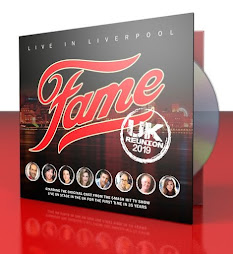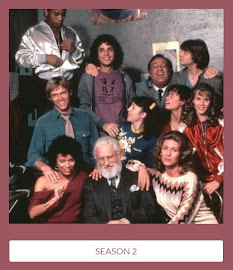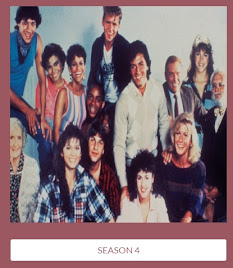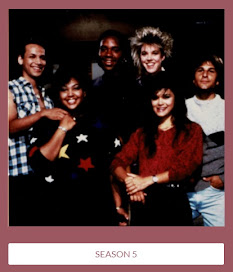Debbie Allen recalls the grittiness of ‘Fame,’ 40 years later: "It was not a Disney movie"
Editor-in-Chief, Yahoo Music May 15, 2020

“I mean, it was not a Disney movie,” Debbie Allen, who famously portrayed tough-loving dance teacher Lydia Grant, tells Yahoo Entertainment. “Homosexuality and abortion, that's just par for the course now, but it wasn't then. Remember when Irene [Cara] had that scene where she had to take their clothes off with that guy? Wow.”

When most people look back on Fame, which celebrates its 40th anniversary this week, they think of the big, boisterous musical numbers: students from the High School of Performing Arts’ Class of 1980 dancing on top of taxicabs in the streets of New York City, riffing about macaroni and baloney in the cafeteria, or singing the body electric as they pick up their diplomas. And that is understandable: The Fame soundtrack, composed mainly by Michael Gore (younger brother of Lesley), was a monster hit and won two Oscars, for Best Original Song and Best Original Score.
But Fame was much grittier and darker than many remember. The groundbreaking and decidedly R-rated musical drama, directed by the great Alan Parker (Midnight Express, Pink Floyd’s The Wall, Angel Heart), unflinchingly tackled previously taboo topics like teen suicide, abortion, closeted homosexuality, illiteracy, and underage pornography.
At the time, the New York Board of Education protested the script’s profanity and adult content, ultimately preventing Parker from filming on the campus of the High School of Performing Arts (now known as Fiorello H. LaGuardia High School) as he had planned. Parker eventually shot all interior scenes at two vacant Chicago-area schools instead.
“A lot of people had a lot to say about that. It was really something,” says Allen. “I don't know why [the school board] wanted to hide from it. I mean, it was New York, come on. If anything is happening somewhere, it's in New York, let's be real. But there was this kind of attitude that LaGuardia had about this movie. … But it took the world by storm, because people related to it because it was so real. That movie was so edgy, and it was so alive.”
The film’s against-the-grain spirit extended to one of the exterior scenes that Parker actually did shoot in New York City: the iconic, literally traffic-stopping "Fame” musical number on 46th Street, which featured eight choreographed routines, 150 student background actors, and 50 professional dancers. (Fun fact: Those dancers performed to Donna Summer’s "Hot Stuff,” because the song "Fame" had yet to be written.) “It was like a riot,” Allen chuckles. New York is New York. The NYPD does not play, and they want to keep things calm. So yeah, there were all these roadblocks; people saying this and saying that. But at the end of the day, Alan Parker got his permits and he did what he needed to do, and he did it rather quickly. He got it in the can before they shut it down.”
The film’s rebelliousness and realism also carried over to its art-imitating-life casting. Fame starred several real-life LaGuardia students, like Laura Dean and, most notably, Gene Anthony Ray. As it turned out, Ray, who played bad-boy Leroy Johnson, had been expelled from the High School for the Performing Arts before he landed the part. “I think he cussed out a teacher. Somebody tried to tell him something. I don't know if it was about pointing his feet, or wearing tights. He said, ‘I'm not wearing that bulls***.’ He never would wear the tights,” Allen laughs.
Allen bonded with the teen cast from the start. “I just remember the energy of all those young people, carrying on in that cafeteria between takes, waiting to shoot a scene,” she says. Allen, a showbiz veteran, had already briefly worked on Broadway with former child actress Cara, who played Coco Hernandez and sang lead on the soundtrack’s “Hot Lunch Jam,” “Out Here on My Own,” and title track (the latter two of which earned Academy Award nominations). “I just can never forget what Irene brought to the screen, into this role, into the world. When she sang ‘Out Here on my Own,’ the day she filmed that song, it was breathtaking, just breathtaking. We didn't know Fame was going to do what it did, but we knew that this was like, whoa. This was something else. She blew it out of the water,” marvels Allen.
Allen’s appearance in the Fame film was brief (“It was proof that there are no ‘small’ parts,” she says of the life-changing opportunity), but she was originally supposed to get more screentime playing Cara’s “nemesis” in the movie. “I was actually supposed to be the senior that was her competition, or so I thought. I had this hot red dress, and I was going to do this song. Then Alan came to me and said, ‘Debbie, you're so beautiful, it's great, but the movie's already 10 hours long, and we haven't even gotten to the end yet, so I'm going to cut your scene.’" I'm like, ‘OK, Alan, I understand. But just make sure I can keep the dress!’”
Allen, now in a much larger starring role, worked with Ray on the successful Fame television series for 116 episodes. But in a tragic storyline that could have been directed by Parker himself, Ray’s career faltered due to his hard-partying ways, and he worked infrequently after the show. One of his few ‘90s credits was the film Out-of-Sync, which Allen directed, and the two stayed in touch until he died at age 41 due to complications from a 2003 stroke.
“Before he died, they had a Fame reunion at my dance studio, the Debbie Allen Dance Academy. It was a big BBC special. There we were, and then all of a sudden Gene Anthony Ray walked in the room and we screamed,” Allen remembers. “We just didn't know that he was going to come, and it was the greatest surprise. That was our last time together physically. Gene and I talked on the phone, but that was the last time we were together. Then he died that fall. I remember going to his funeral in Harlem, a big funeral, and it was very difficult for me.”
Allen has tried to keep the Fame legacy alive in the years since. Yes, she does still have that red dress, and this year she choreographed the Grammy Awards’ "I Sing the Body Electric” number (which featured Lee Curreri, the actor who’d played Bruno Martelli in both the Fame movie and TV show). She also starred in the film’s 2009 remake, although she admits now that that sanitized, PG-rated version, which Parker disavowed, was “disappointing.”
“When they went to remake it, they just didn't go far enough,” Allen laments. “There would have been an opportunity to talk about AIDS and a whole lot of things now that were really a big part of the artistic community. It just never went far enough. I mean, if you're going to do Fame again, you have to go further.” She also wasn’t so thrilled with her 2009 wardrobe, which unfortunately did not include any sort of sexy red dress. “I was the only [cast member] that was coming in from the original, and then they wanted to act like I was not Lydia Grant. I remember them wanting to put me in some kind of pearls. I'm like, ‘What? That's not Lydia Grant!’ They said, ‘Well, we tried to dress you a little more like Condoleezza Rice.’ I said, ‘Look, I love Condi, I think she's amazing, but that's not Lydia Grant. Lydia Grant wears big earrings. Her hair is a lot. No.’ I was there, but it was not what I had hoped it would be.”
But Allen will forever be proud of the 1980 original and the 1982-87 television show, which she considers the West Side Story and Glee of its era. “Fame was just such a calling card for the world,” she proclaims. “It was ahead of its time, in a way. But no, it was right on time. It really was right on time.”



















.png)





















No comments:
Post a Comment